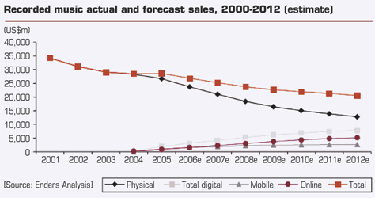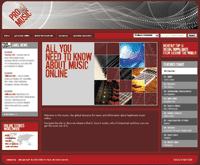
The Digital Music Market - Educating Users
The Digital Music Report 2008 compiled by IFPI, which represents the recording industry worldwide, estimates that worldwide earnings for the record industry in digital music sales topped US$2.9 billion in 2007 – a 40 percent increase over 2006. Not bad considering that the industry was non-existent in the digital market five years ago. But will the double-digit growth in digital sales counter industry losses on physical CD sales, falling since their US$45 billion peak in 1997? Not by a long shot, if the Enders Analysis forecast in its March 2007 “Recorded Music and Music Publishing” report proves correct.

IFPI identifies rampant illegal downloading and peer-to-peer (P2P) file sharing as the number one reason why digital sales have not made up for the slow down in CD sales. It calls for Internet Service Providers (ISPs) to act by suspending and disconnecting the accounts of copyright infringers and by applying filtering measures, noting that tens of billions of illegal files were swapped in 2007 – a ratio of twenty unlicensed downloads to each legal one. IFPI suggests that new revenue sharing models with ISPs may provide the incentive for them to act against piracy. Legal action against ISPs may also further encourage cooperation with the music industry. (See also, In the Courts: Pursuing the P2P Pirates in this issue of the WIPO Magazine.)
The music industry is also looking to remedy the situation by reaching out to the users. The pro-music.org site was launched three years ago with the endorsement of the music industry worldwide – from musicians and managers to major record labels, retailers, performers and publishers – to educate the public on the legal download of music. The site links to resources for educating parents so that they can in turn teach their children to use the Internet responsibly (see box).
This approach is in line with the findings of the Microsoft Survey of Teen Attitudes on Illegal Downloading, conducted in January. The survey showed that their parents were the first source of information for teenagers on the rules related to downloading. Moreover, the survey found that the more teenagers know about copyright, the better they understood that illegal downloading is a punishable offense. However, the older the teenagers, the less likely that knowing the rules would change their downloading habits. The findings of the survey suggest that outreach efforts which target parents and get them to teach their children how to download files legally may have better results than those which try to target teenage file swappers directly.
Adapting to new challenges
The Internet has created a new online world teeming with both opportunities and obstacles for the music industry. The IFPI Report states that “the ease of access to music has damaged its perceived financial value to consumers,” creating a huge challenge for the music industry. A challenge to which the industry has been, according to its critics, slow to react. IFPI admits that the record companies are only now reinventing themselves, creating new business models to survive – and thrive – in the digital environment.
The Enders report concurs, “as we analyze core challenges, we consistently find the industry […] has often appeared caught short, and its reactions are accordingly wrong-footed.” It gives as examples the industry’s backing of their own online subscription services in 1999 when P2P was emerging and their subsequent refusal to license to download services until their own subscription services failed. However, Enders cites Universal’s decision in 2007 to license master recordings to YouTube as evidence that the industry has started to re-orient itself.
But the Enders report points to a few other problems areas for the industry. First, the decline of the album. Today’s music lovers are no longer willing to buy an album for the sake of one or two favorite songs. They would rather go to the Internet, download a single and pay less. Second, Enders notes that the music industry surge of the 1980s and 90s came from fans rebuilding their libraries, buying CDs to replace their vinyl record collections – a one-time occurrence that the digital revolution will not replicate. Third, growing apathy. Many fans say they are disenchanted with the low-quality product the industry is offering.
Enders’ findings are reinforced by a Rolling Stone/Associated Press poll of 1,000 adults, carried out in 2006 by market research company Ipsos. 58 percent of respondents claimed that music quality – and talent – was on the decline. Interestingly, although 71 percent of those same respondents believed 99 cents a fair price – if not an outright bargain – for a song, 75 percent also claimed that CD prices were too high.
Only time will tell how the music industry will reinvent itself, which models will work and which industry paradigms will have to be discarded. The Internet has changed our world, there will be no going back. The survivors will lick their wounds and find the way ahead.
| Promoting Legal Downloading |
|---|
|
The updated and redesigned www.pro-music.org site was launched in April with the strap line: “All you need to know about music online”. The site is an authoritative information source that promotes positive, educational messages about music online. Its unique selling point remains its links to a comprehensive directory of legal music sites worldwide. New content includes:
The updated “Young People, Music and the Internet” guide was launched at the same time as the new Pro-music website. Authored by Childnet ( non-profit organization that works with governments to make the Internet a safe place for children), with input from the cross-sector Pro-music alliance, the leaflet aims to help ensure young people enjoy music and stay safe, secure and legal “at home, at school and on the go.” Pro-music has discerned a real demand for this simple all-you-need-to-know guide. The leaflet, which will be linked to a more comprehensive information website run by Childnet, does the following:
It features a laminated pull-out card, addressed to young people, which aims to get the discussion going between the adults and the kids. A first mailing will go to over 5,000 schools and 3,000 libraries in the UK. Adapted versions are planned in France, the U.S.A., Australia, New Zealand, Taiwan, Sweden, Argentina, China and Singapore with more to follow. |
By Sylvie Castonguay, WIPO Magazine editorial team, Communications and Public Outreach Division
The WIPO Magazine is intended to help broaden public understanding of intellectual property and of WIPO’s work, and is not an official document of WIPO. The designations employed and the presentation of material throughout this publication do not imply the expression of any opinion whatsoever on the part of WIPO concerning the legal status of any country, territory or area or of its authorities, or concerning the delimitation of its frontiers or boundaries. This publication is not intended to reflect the views of the Member States or the WIPO Secretariat. The mention of specific companies or products of manufacturers does not imply that they are endorsed or recommended by WIPO in preference to others of a similar nature that are not mentioned.
